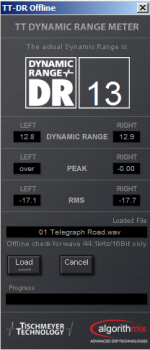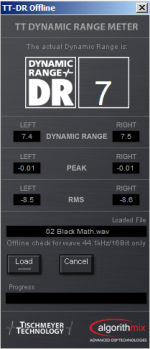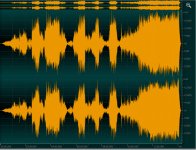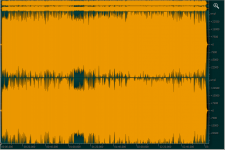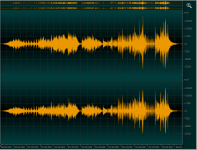Pano said:It just doesn't sound recorded. I still don't know why.
If you record a band with a single mic at a distance and play it back, you'll get a static version of the venue's ambience (doesn't matter if you turn our head or move around) and it sounds bad, plus you add your room's ambience. So to make it sound more realistic you mic more closely so as to lose some, or most, of the venue's ambience. But the venue was what made the music sound 'live' in the first place, so you need to keep a bit of it in the recording. However, the venue's 'modes' don't line up with your listening room's, so you don't get the same huge boosts and dips in amplitude at certain frequencies that you heard at the live event. The musicians subconsciously responded to those 'modes' and their changes in playing technique won't mean anything in your room. And acoustic feedback back into mics and stringed instruments (for example) at the live event will also have been hitting certain 'modes' that won't come across in the same way in your listening room.
Last edited:
"Orwell Interconnects" Two guesses on the model number of the first product.
101
The number of the room in '1984' where people were taken for re-education although nobody ever left that room...at least not alive.
As for drums: My favourite way of mic'ing them uses 3 mics, one on the kick and a mid-distance stereo pair.
Last edited:
There is a BIG difference in the dynamic range. Modern day recordings tend to be squeezed within an inch of their life. Everything is squashed together in an almost equally loud mismash of sound. I assume the reason is that to get decent volume out of an iphone/ipod the recording needs to be close to the limits.
Tony.
Historically speaking the Loudness Wars started in the '90s with the arrival of CD changers in the car and at home.
During 'normal' background music use the louder CDs (those with heavily squashed dynamics) stuck out in a memorable way to the non-discerning consumer. 'Memorable' is like catnip to the marketing bods of any corporation and record companies were no different.
Why should it sound bad?If you record a band with a single mic at a distance and play it back, you'll get a static version of the venue's ambience (doesn't matter if you turn our head or move around) and it sounds bad, ...
Why should it sound bad?
You mean "Why does it sound bad?". Because it is static and recorded from a fixed position using only two mics - we're not talking sonic holography here. In the live situation you can move around, turn your head, and receive cues from all around you allowing you to hear past the room's acoustics.
It's very simple to demonstrate: make a recording of your hi fi system with the mic a few feet from the speakers, then play it back on speakers or headphones. Unless your room is an anechoic chamber, what you get is nothing like what you experience when listening to your system 'live'. It sounds much more 'hollow' and 'distant' than you might expect. This is a phenomenon I experienced the first time I played around with a tape recorder as a child.
on the low dynamic range, whilst trying to find a visualizer I have used in the past but can't remember the name of I came across this Measure the dynamic range of your CDs and downloads Tim Anderson's ITWriting
I downloaded the tt-DR software and ran it over something I consider has good dynamic range (and sounds good) and then over something I consider doesn't have good dynamic range and tends to sound bad on my system.
The Dire Staights not surprisingly is pretty close to the magic number of 14 (missing by one at 13) The track I like the most on that album actually comes in at 17.
Black Math off whitestripes Elephant was better than I was expecting, coming in at 7 but on my system it sounds pretty awful.
The waveforms are Telegraph road first, and then Black Math.... perhaps it is not so much the dynamic range but the density of the music that is the problem, with my system not being good enough to handle the dense sound. But certainly the White stripes is more than fatiquing. it is virtually unlistenable! 🙂
edit: I've added the waveform for Private Investigations which got a DR rating of 17.
Tony.
I downloaded the tt-DR software and ran it over something I consider has good dynamic range (and sounds good) and then over something I consider doesn't have good dynamic range and tends to sound bad on my system.
The Dire Staights not surprisingly is pretty close to the magic number of 14 (missing by one at 13) The track I like the most on that album actually comes in at 17.
Black Math off whitestripes Elephant was better than I was expecting, coming in at 7 but on my system it sounds pretty awful.
The waveforms are Telegraph road first, and then Black Math.... perhaps it is not so much the dynamic range but the density of the music that is the problem, with my system not being good enough to handle the dense sound. But certainly the White stripes is more than fatiquing. it is virtually unlistenable! 🙂
edit: I've added the waveform for Private Investigations which got a DR rating of 17.
Tony.
Attachments
Last edited:
IME this behaviour is dependent upon the quality of playback - when working at optimum level the cues are very evident, the acoustics of the recording take over that of the listening area, at least subjectively.In the live situation you can move around, turn your head, and receive cues from all around you allowing you to hear past the room's acoustics.
It's very simple to demonstrate: make a recording of your hi fi system with the mic a few feet from the speakers, then play it back on speakers or headphones. Unless your room is an anechoic chamber, what you get is nothing like what you experience when listening to your system 'live'. It sounds much more 'hollow' and 'distant' than you might expect. This is a phenomenon I experienced the first time I played around with a tape recorder as a child.
And this follows through to recording the playback. This does sound like the subjective impression of the sound, when the reproduction was of a high standard.
...certainly the White stripes is more than fatiquing. it is virtually unlistenable! 🙂
Ah well, there's your problem you see. Elephant was recorded at all-analogue Toe Rag studios:
Toe Rag Studios - Wikipedia, the free encyclopediaToe Rag offers clients music production using eight-track multitrack recording technology, and all recording media is magnetic tape.
Equipment
Recording is centred around an EMI mixing console (originally from Abbey Road Studios[3]) and Studer A80 tape machine...
If they'd used modern, high quality digital... 🙂
For me fatigue is mainly caused by blaring midrange. Our ears don't hear low frequency sounds at the same volume level as we hear mid frequency sound. We would have to boost the low frequency volume considerably to compensate however I have not yet heard tone controls/graphic equalizers which don't mess up the sound quality. When we get over 40 years of age we don't hear much at all above 14khz which I think exaggerates the mid frequencys to some extent but that is my opinion, I cant offer any proof obviously.
I have the old analog (flac), but not the newer version. Tony is yours the old analog or the newer version?
When we get over 40 years of age we don't hear much at all above 14khz
I believe this to be the truth but it's surprising how many people round here say "As I'm over 50, I don't hear much above 18 kHz these days...".
Aye CopperTop it is a laugh, unless they transplant the ears of a kid onto the sides of their heads, they wont hear anything above 15kHz never mind 18.
I'm 43 with good hearing and I hear nothing at 16k but there is a big gap in the test with no tones between 12 & 16k. I can hear 12k although it does sound surprisingly high pitched.
Mooly linked this test in another post.
Equal loudness contours and audiometry - Test your own hearing
I'm 43 with good hearing and I hear nothing at 16k but there is a big gap in the test with no tones between 12 & 16k. I can hear 12k although it does sound surprisingly high pitched.
Mooly linked this test in another post.
Equal loudness contours and audiometry - Test your own hearing
To sum up:
It's not the amps
Its not all of your music sources, though some will be crappy.
It's certainly not your umm "interconnects"
It's going to be the room-speaker circuit.
Here is my personal opinion. One of those PA speakers you see around here with nice paint masquerading as hifi would be a good compromise if you don't have room for something like a Khorn , Sentry iii Altec 19 Cornwall. Large well designed flat 3 way speakers that could also be used as PA will get you in the high efficiency high dynamic, low distortion ball park. That and carpet drapes and a couch or two.
It's not the amps
Its not all of your music sources, though some will be crappy.
It's certainly not your umm "interconnects"
It's going to be the room-speaker circuit.
Here is my personal opinion. One of those PA speakers you see around here with nice paint masquerading as hifi would be a good compromise if you don't have room for something like a Khorn , Sentry iii Altec 19 Cornwall. Large well designed flat 3 way speakers that could also be used as PA will get you in the high efficiency high dynamic, low distortion ball park. That and carpet drapes and a couch or two.
Yeah, the big offender is peaky upper midrange, for sure. That can be the speakers, the room, the recording and sometimes even the amp.
Take care of that and you'll go along way. The rest of it is subtle stuff.
FWIW, flat response as measured at the listening chair is fatiguing to me. I have to use the classic 6dB downward slope from ~400Hz to 20Khz.
Take care of that and you'll go along way. The rest of it is subtle stuff.
FWIW, flat response as measured at the listening chair is fatiguing to me. I have to use the classic 6dB downward slope from ~400Hz to 20Khz.
Yeah, the big offender is peaky upper midrange, for sure. That can be the speakers, the room, the recording and sometimes even the amp.
Take care of that and you'll go along way. The rest of it is subtle stuff.
FWIW, flat response as measured at the listening chair is fatiguing to me. I have to use the classic 6dB downward slope from ~400Hz to 20Khz.
I have the same issue, I might have a go at making a passive tone control like the one described here - 41Hz Audio - Passive tone control
if it's rubbish, at least I wont have spent a lot on it 😀
Yes to both, I say. 😀 The passive tone control should give you more adjustment that you ever need. Certainly worth a try.
Drapes, soft furniture, carpet and rugs sure do help. I also made large acoustic panels for my room, which help tremendously to tame the midrange peak in the room.
Drapes, soft furniture, carpet and rugs sure do help. I also made large acoustic panels for my room, which help tremendously to tame the midrange peak in the room.
Miles more than enough I should think ...
badman, how would you assess whether speakers could handle the extra headroom, as a serious question?
Heck if I know. I haven't yet found the limits of upscaling amps and speakers on dynamic range, I don't think. But regarding what I think of as limits of speaker output are a combination of excursion requirements, power handling, and distortion (of various types). I've used well-refined small speakers with extended xmax. While they can play well they're not the same as a fullscale speaker system, particularly as SPL goes up. Yes, they will play loud, but every time that small driver is bouncing around it's distorting badly. This is a UNIVERSAL TRUTH in speakers. If the driver is being asked to handle it's limits or beyond, it's performing at it's worst.
My Galacticons used the CSS FR125, one of the highest output capable small fullrangers around, which are on a well optimized spherical aluminum enclosure. This is basically the ultimate iteration of a small computer style speaker, to my way of thinking. That limit is WELL before the 120dB you claim later in this thread, even at a few hundred hz.
What you call well-behaved, or "clean" is a badly distorted sound if your level claims are to be believed. A typical computer speaker driver, NO MATTER WHAT YOU DO TO THE CABINET, will have 50%+ THD at any frequency <400Hz at 105dB. Some high power pro style mid drivers can do high spl in the midrange with a relatively small driver, but cheap drivers can only do so much. Power handling means bigger better made coils and formers and better adhesives, more excursion requires more magnet for a given efficiency, and just efficiency itself is not sufficient.
Cheap computer speakers have not the magnet, not the shaping of the motor parts, not the voicecoil, not the top plate, not the suspension, to do 100+ dB. Some of the Logitech systems use tang band speakers with much higher standards than Altec (name only PC junk), but they're STILL in trouble when asked to do anything above about 80 continuous. 100dB peaks with good recordings are really at their limits, even in the small close setups their used in. When you want to fill a larger space you need a larger system quickly.
It's not a question of "is it loud enough for me", it's a question of "is it loud enough for me while remaining clean?"
A 10W resistor at full dissipation is very hot, often >200 degrees (bigger, more expensive higher reliability resistors stay cooler for a given dissipation due to integral heatsinks, more dissipation area, etc). Most drivers would never handle their rated input power, and small PC speakers typically find their thermal limits at 10 watts. Their Xmax is usually 1mm or so, rarely do they have large overhangs or suspension support for more excursion.
There's simply a lot more on tap with bigger systems, from power handling (midrange) to excursion, to suspension, to surface area. Think about the biggest horn systems- you think most of those guys really want them that big? They are big, not because they listen that loud, but because they want the complete effortless dynamic sound that comes with scaling things up.
You seem to have a philosophy centered around "letting the inherent goodness out". But the biggest choke in a speaker is not something that can be changed outside of changing the driver, and once you reach the limits of the driver size with more expensive units with rare earth metals, good adhesives, and high xmax both in the suspension and motor, you STILL are left with something that can't keep up with big systems, even at low levels. There's a limit to how much "good/loud" you can cram into a small driver. Bigger high efficiency systems just sound more clean and open (and can rock a whole lot louder). Consider an instrument- the surface deflection is generally small, but over a large surface area.
Yes, I think I understand what you mean. Midbass alone doesn't do it. But when I add the midbass to the rest of the signal, I hear spacial cues. Take it away and the sense of space vanishes. Is that what you mean?I would say the same but I could only say this when the mid-bass is integrated with the midrange, and this puts this in doubt.
- Home
- Loudspeakers
- Multi-Way
- What causes listening "fatigue"?
